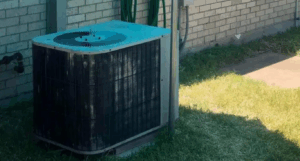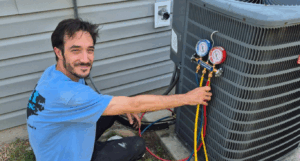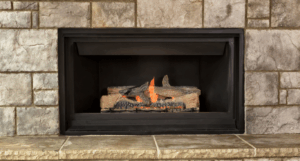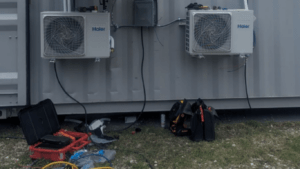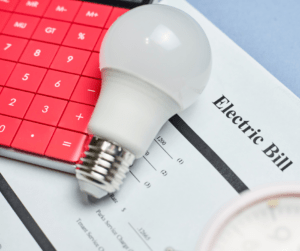Tips to Cut Your Electric Bill This Winter

Decoding Your Electric Bill
To effectively lower your electric bill, start by getting to know its various components. Your bill generally includes a basic service charge, which is a fixed cost, and a usage charge, which fluctuates based on your electricity consumption. Additional taxes and fees may also be part of the total. The key to reducing your energy bill lies in the usage charge, as it directly reflects how much electricity you use, typically measured in kilowatt-hours (kWh).
Examine your previous bills to identify any trends or spikes in usage. Pay special attention to the months when your bill is higher, and think about the activities or appliances that might be contributing to increased consumption. For instance, using space heaters, and holiday lights, or running your HVAC system more frequently could cause noticeable upticks.
Understanding your usage patterns will help you determine where you can make cuts. Are you leaving lights on in unoccupied rooms, or is the TV running as background noise for hours? Simple behavior changes, like turning off lights when leaving a room or unplugging devices not in use, can lead to significant savings over time.
Many utility companies offer detailed breakdowns of your usage, sometimes even by the hour. Taking advantage of these insights can be a game-changer in pinpointing areas to reduce consumption. Additionally, consider using energy monitors, which can help you track the energy usage of specific devices and appliances. By focusing on the components of your bill and identifying where your electricity is being used the most, you’ll be well-equipped to implement effective strategies to lower your electric bill this winter.
Insulate Your Living Space

Insulating your home is a straightforward and impactful way to cut down on energy costs during the winter. Begin by sealing any drafts you find around windows and doors using weatherstripping or caulking. This simple step can prevent cold air from entering and warm air from leaking out, making your heating system’s job much easier.
Consider adding thick curtains, particularly thermal ones, to help retain heat inside your home. Close these curtains at night to trap warmth and open them during the day to let in natural light and warmth. Draft stoppers can also be a small but effective addition; place them at the bottom of doors to block chilly drafts.
Don’t forget about your attic and basement. These areas can be significant sources of heat loss. Adding insulation to your attic can dramatically improve your home’s energy efficiency. Similarly, check your basement for any gaps or cracks that could be letting heat escape and cold air in.
Floor coverings can also play a role in insulation. Rugs and carpets add an extra layer of warmth and can help keep your feet cozy, reducing the temptation to crank up the thermostat.
For a more permanent solution, consider upgrading your windows to double-pane or energy-efficient models. While this requires an upfront investment, the long-term savings on your electric bill can be substantial.
If you have a fireplace, make sure to close the damper when it’s not in use to prevent warm air from escaping through the chimney. A fireplace insert can also improve energy efficiency by directing more heat into the room.
By taking these steps, you can make your home more energy-efficient and reduce your electric bill, all while staying warm and comfortable.
Set Your Thermostat Wisely

Your thermostat settings can greatly impact your electric bill during the winter. By making some smart adjustments, you can keep your home comfortable while using less energy. Start by lowering the thermostat when you’re asleep or away from home. This simple change can make a noticeable difference in your energy consumption and reduce costs.
Consider upgrading to a programmable thermostat if you haven’t already. These devices allow you to schedule temperature changes automatically, so you don’t have to remember to adjust it yourself. For instance, you can set it to lower the temperature during the hours you’re at work and then warm up the house just before you return. Many modern thermostats even offer smartphone apps, letting you make adjustments from anywhere.
Another tip is to layer up with warm clothing and use blankets while relaxing at home. This way, you can stay comfortable without having to increase the thermostat settings. Remember, for each degree you lower the thermostat, you could save up to 1% on your heating bill, which can add up over the winter months.
Zoning systems are another option to consider, especially if you have a larger home. These systems allow you to control the temperature in different areas of your house independently. For example, you can keep common areas warmer while maintaining cooler temperatures in unused rooms. This targeted approach ensures you’re only heating the spaces you use most, reducing overall energy consumption.
By paying attention to your thermostat settings and making a few strategic adjustments, you can lower your electric bill without sacrificing comfort.
Enhance Heating System Performance
Keeping your heating system in top shape is essential for lowering your electric bill during the winter. Start with the basics: change or clean your filters every month. Clean filters ensure your system doesn’t have to work harder than necessary, which helps reduce energy consumption. Additionally, take a look at your vents and air returns—make sure they aren’t blocked by furniture or drapes to allow for proper air circulation.
It’s also a good idea to schedule a professional check-up for your heating system before the cold weather sets in. A technician can inspect the system for any potential issues and perform necessary maintenance to keep it running efficiently. This can prevent small problems from turning into costly repairs and ensures your system is operating at its best.
Consider upgrading your thermostat to a programmable model if you haven’t already. This small investment allows you to set a heating schedule that matches your daily routine, ensuring you use energy only when you need it. Many modern thermostats even offer smart features, like remote control via smartphone apps, providing you with the convenience to adjust settings from anywhere.
If you have an older heating system, it might be time to think about an upgrade. Newer models are more energy-efficient and could save you a significant amount on your electric bill in the long run. Even if a full HVAC replacement isn’t in the budget, upgrading specific components, such as the blower motor, can enhance your system’s performance.
By focusing on these aspects of your heating system, you’ll not only improve its efficiency but also see a reduction in your electric bill, helping you stay warm without extra costs Gas Line Installation Services.
Invest in Energy-saving Appliances

Investing in energy-saving appliances can make a significant difference in reducing your electric bill. When it’s time to upgrade old appliances, look for those with Energy Star ratings. These certified appliances are designed to use less electricity without sacrificing performance. Whether it’s your refrigerator, washing machine, or dishwasher, opting for energy-efficient models can lead to substantial savings over time.
Switching from traditional incandescent bulbs to LED lighting is another easy and effective way to cut down on energy usage. LED bulbs consume up to 75% less energy and last much longer, which means you’ll be buying replacements less often. This simple change can reduce your electricity costs considerably.
For cooking, consider using a microwave or toaster oven instead of a conventional oven for smaller meals. These appliances generally use less energy and can cook food more quickly. Additionally, an electric kettle is more energy-efficient for boiling water compared to using a stove.
When shopping for new appliances, pay attention to the energy usage labels. These labels provide an estimate of how much electricity the appliance uses annually, helping you make an informed decision. Also, think about the size of the appliance. Bigger isn’t always better; choose a size that fits your needs to avoid unnecessary energy consumption.
By opting for energy-saving appliances and making smart choices, you can lower your electric bill while enjoying the benefits of modern, efficient technology.
Make Use of Natural Sunlight

Natural sunlight is a free and powerful resource that can help heat your business or home. During the day, open curtains or blinds to let sunlight in, especially on south-facing windows, as these capture the most warmth. Arranging your furniture to maximize exposure to sunlight can also help. By placing seating and dining areas in sunny spots, you can enjoy warmth and light without extra cost. Just remember to close the curtains at night to keep the warmth from escaping back out through the windows.
By implementing these strategies, you can take control of your electric bill this winter. Each small change adds up, leading to noticeable savings and a more energy-efficient home. So, embrace these tips and enjoy a warm, cost-effective winter!
Conclusion
By following these steps you have learned here today, you should be able to reduce your electric bill this winter saving you a nice chunk of change. To learn more heating and air conditioning tips for both homes and businesses, be sure to read our following related articles.



